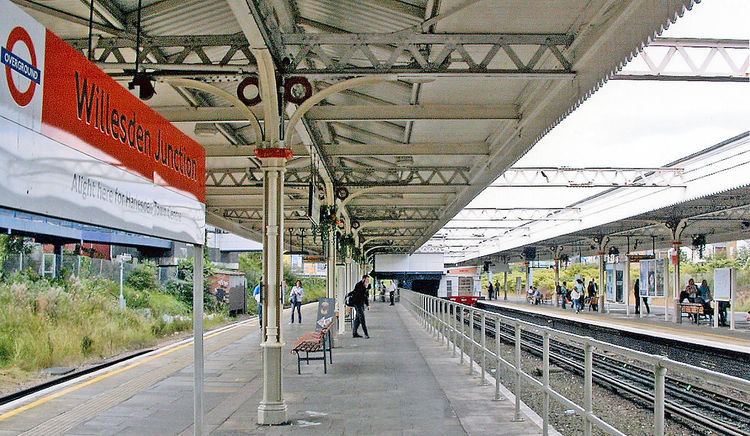Station code WIJ Accessible Yes Opened 1866 | DfT category C2 Fare zone 2 and 3 Number of platforms 5 | |
 | ||
Similar Wembley Central station, Harrow & Wealdstone station, Stonebridge Park station, Harlesden station, Kensal Green station | ||
London overground capacity improvement works improvements at willesden junction station
Willesden Junction is a Network Rail station in Harlesden, north-west London, UK. It is served by both London Overground and the Bakerloo line of the London Underground.
Contents
- London overground capacity improvement works improvements at willesden junction station
- Trains willesden junction station 11th february 2017
- History
- Accidents and incidents
- The station today
- Motive power depot
- Services
- Other Public Transport Connections
- References
Trains willesden junction station 11th february 2017
History
The station developed on three contiguous sites:
In 1896 staff totalled 271, including 79 porters, 58 signalmen (in 14 signal boxes) and 58 shunters and yard foremen. They issued 1,006,886 tickets to passengers in 1896, up from 530,300 in 1886. Many of them were housed in what is now the Old Oak Lane conservation area, built by the LNWR in 1889 and which included an Institute, reading room and church.
The main-line platforms were numbered from the south side (including one or two on the Kensington route) followed by the high level platforms and then the DC line platforms which thus had the highest numbers. Later the surviving platforms were re-numbered.
Accidents and incidents
The station today
There are no platforms on the West Coast Main Line, which is separated from the low-level station by the approach road to Willesden Depot which lies immediately south-east of the station.
The high-level (HL) station consists of an island platform rebuilt in 1956, with faces as platforms 4 and 5, which are roughly at the level of Old Oak Lane to the west of the station, serving the NLL and the West London Line; some trains on the latter reverse in a central turnback siding on the NLL to the east of the station, this opened in 2011. Both platforms have been extended across the DC line to accommodate 4-coach class 378 trains. The HL station previously had a third platform on the eastern side which was used by services to/from Earls Court. There is another turnback siding further east which was previously used; it was laid in the late 1990s to allow Royal Mail trains to reach the Royal Mail depot at Stonebridge Park.
The low-level station, at the level of the area to the south, is an Edwardian island platform, with outer faces as platforms 1 and 3 and northern bay platform bay as platform 2, the southern bay now has no track. In October 2014 the DC line was closed temporarily between Wembley Central and Queens Park reportedly by Network Rail (London Overground) to allow platform 2 to be extended further west as a through platform. Most of the original and later platform buildings were demolished when platform 2 was extended in preparation for longer Class 378 trains and provision of a new footbridge and lift in 1999.
Platforms 1 and 3 are used by the Bakerloo line services, which began on 10 May 1915. and London Overground services between Euston and Watford Junction. Until May 2008 north-bound Bakerloo line trains which were to reverse at Stonebridge Park depot (two stations further north) ran empty from Willesden Junction although the southbound service began at Stonebridge Park. This imbalance arose as there were no London Underground staff beyond Willesden Junction to oversee passenger detrainment, but this changed after London Underground took over the staffing of stations on the line, including Stonebridge Park, from Silverlink in November 2007, and trains bound for Stonebridge Park depot now terminate at Stonebridge Park station. Normally only the first and last NLL trains of the day, which start or terminate here, use the bay platform, though it is used for empty stock transfers between the depot and the North London and Gospel Oak to Barking lines.
The station signs on the platforms say, below the Overground roundel, "Alight for Harlesden town centre".
Motive power depot
The LNWR opened a large locomotive depot on a site on the south side of the main line to the west of the station, in 1873. This was enlarged in 1898. The London Midland and Scottish Railway opened an additional roundhouse on the site in 1929. Both buildings were demolished when the depot was closed in 1965 by British Railways and replaced by a Freightliner depot. (The servicing of locomotives and multiple units was then undertaken by the present Willesden TMD on the other side of the line.)
The steam depot had the shed code 1A and was a major depot for predominantly freight locomotives used on the West Coast Main Line and for suburban passenger services from Euston.
Services
The typical off-peak London Underground service at Willesden Junction is six Bakerloo line trains per hour (tph) between Elephant & Castle and Harrow & Wealdstone and three Bakerloo line trains per hour (tph) between Elephant & Castle and Stonebridge Park.
London Overground services are normally operated by Class 378 Capitalstar units. The typical off-peak North London Line, West London Line and Watford DC Line services at the station in trains per hour are:
Southern Railway services travelling between Milton Keynes Central/Watford Junction and the South Croydon/East Croydon, and slow London Midland services travelling between London Euston and Tring, currently do not stop at this station, as there are currently no platforms provided on the lines which previously passed through the southernmost platforms of the main line station, and which now form the up and down Willesden relief lines. However, in the future there is a proposed plan for these services to stop here, which will involve building new platforms on the WCML.
Other Public Transport Connections
The station area is served by London Buses routes 18, 220, 228, 266, 487 and night route N18.
